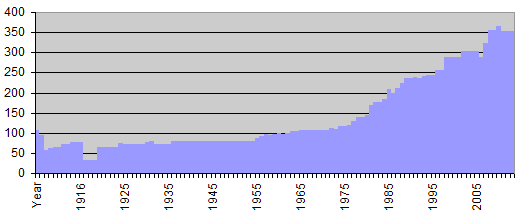This page contains information on the evolution of the Observer's Handbook: number of pages, use of colour, advertising, and more.
- The Handbook binding used staples from 1920-55.
- From 1968 onwards, the title was printed on the spine.
- Glossy cover material was used starting in 1979, except for 1985 and 1986.
- Starting with the 1960 edition, the covers were a different colour each year.
- The 1966 edition used red ink on the covers (inside and out).
- From 1969 through 1974, the Standard Time Zone map was printed in colour.
- The 1907 edition contains a photo of the first quarter moon.
- 1979: front cover photo started.
- 1996: front cover photo now repeated on back cover (also in 1990).
- 2006: back cover photo now different from front cover.
Monthly sky maps were included in the 1907 and 1908 editions, as well as most of the 1909-11 bimonthly installments published in JRASC (and not as separate annual volumes).
From 1912-17 a complete star atlas, consisting of four fold-out charts, was published.
A set of four seasonal all-sky star maps appeared from 1938-71. This was followed by a busier set for 1972-75. From 1976-81 a prettier set of maps (closer to the 1938-71 version in appearance, but now numbering six charts) by John Perkins was used. Roy Bishop introduced a new set of charts in 1982. In 1985 this was expanded with the addition of a single chart for the southern sky.

What's interesting is that the first period of growth in 1956 was mostly the addition of paid advertising in the extra pages at the back of the handbook. This continued in the coming years, typically 6 to 8 pages, and the advertisements were not always astronomy related. One year there is a quarter-page ad from Bank of Montreal! The biggest change was in 1976, there were the same number of pages, and no ads at all from that issue forward.
—Patrick Kelly, Observer's Handbook Editor 2007-11
The preface to the 1950 edition states:
During the past decade its circulation has increased from 1500 to 5500.
Five other editions from the 1950s also give circulation figures in their prefaces:
- 1952: 5,000
- 1953: 5,000
- 1954: 5,000
- 1955: 5,500
- 1956: 6,000
- 1960: 8,500 [Ref: XC Minutes 1960 July 8]
- 1962: 9,600 [Ref: Administration Bulletin No. 1]
- 1963: 9,600 [Ref: Administration Bulletin No. 1]
- 1970: 12,000 [Ref: Northcott file, p. 309]
- 1978: ~15,000 [Ref: S&T, Aug. 1978, p.125]
- 1982: 16,000 [Ref: letter from Freeman to Bishop, 1981 Aug 31—see Lossing file]
Advertising first appeared in the 1948 edition and carried through to the 1975 edition.
| Year | # Pages/Locations of Ads |
|---|---|
| 1948 | IBC, OBC |
| 1949 | OBC |
| 1950 | IBC + ad on 80 |
| 1951 | IFC1, OBC |
| 1952 | IFC1, IBC, OBC |
| 1953 | IBC1, 4 (incl. IBC, OBC) |
| 1954 | 3½ (incl. IBC, OBC) |
| 1955 | 4 + IFC1 |
| 1956 | 10 + IFC1 |
| 1957 | 10 + IFC1 |
| 1958 | 12 + IBC1 |
| 1959 | 12 + IBC1 |
| 1960 | 10 + IFC1 + IBC1 + ads on 31, 59, 62, 63 |
| 1961 | 11 + IBC2 + ads on 60, 63, 64, 79 |
| 1962 | 7 + IFC1 + IBC1 + ads on 65, 81 |
| 1963 | 9 + IBC2 + ads on 31, 69, 83 |
| 1964 | 11 + IBC1 + ads on 69, 83 |
| 1965 | ? |
| 1966 | 12½ (incl IBC) + ads on 31, 69, 71, 73, 87 |
| 1967 | 11 (incl IBC) + ads on 71, 73, 94 |
| 1968 | 9½ + IBC1 + ads on 73, 87, 94 |
| 1969 | 9½ + IBC1 + ads on 11, 59, 73, 87, 94 |
| 1970 | 10 (incl IBC) + ads on 31, 62, 69, 73, 94 |
| 1971 | 8 + IBC1 + ads on 11, 31, 57, 74, 87, 95 |
| 1972 | 8 + IBC1 + ads on 31, 58, 64, 65, 97 |
| 1973 | 9 (incl IBC) + ads on 31, 57, 58, 64, 78, 91, 100, 101 |
| 1974 | 10 + ads on 11, 55, 56, 67, 76, 89, 98, 99 |
| 1975 | 10 + ads on 11, 46, 65, 69, 72, 80, 93, 102, 103 |
IFC = inside front cover; IBC = inside back cover; OBC = outside back cover; # of ads on cover is also indicated where ads do not occupy the full page; page numbers are given for ads not at the front or back.
- Log in to post comments
